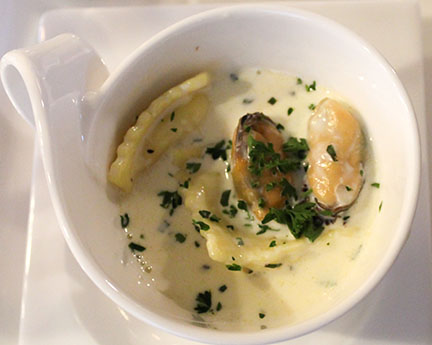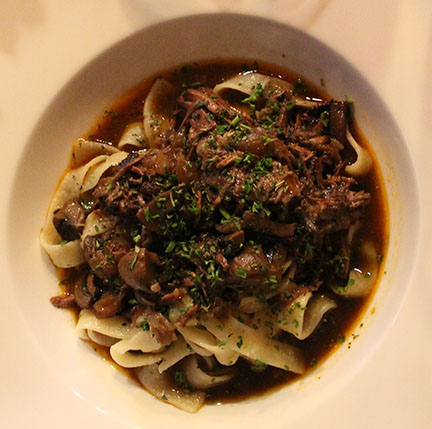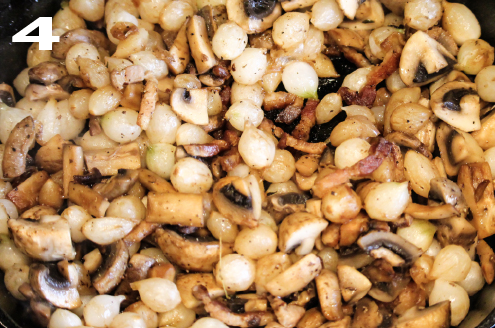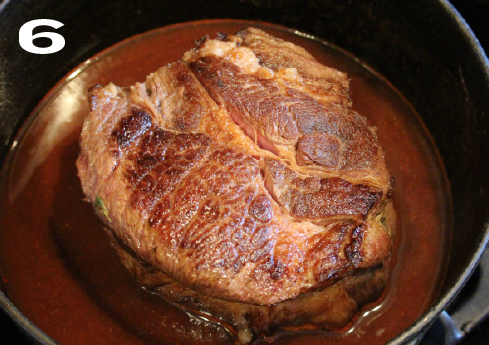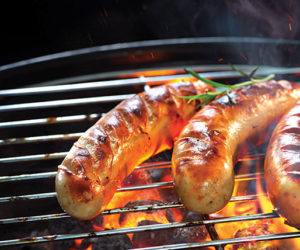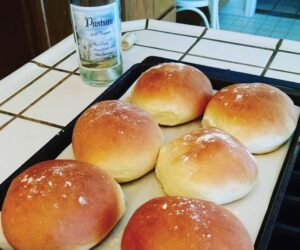The first thing that most people say when I tell them how I spend my summer is, “Can I come?”
As the chef for Northern Arizona University’s School of Hotel and Restaurant Management I get to teach our students the foundations of how a professional kitchen operates. During the summer 18 students get a tour and tasting of French gastronomy over 20 days that begins in Nice and ends with a picnic underneath the Eifel Tower. The purpose of the trip is to understand the concept of terroir. Simply put, terroir is the notion that a product has a sense of place. When you are tasting a 2002 Côte de Beaune, you are not just drinking wine, you are experiencing the weather patterns and the growers, makers, and cellars care, skill, and knowledge that went into its production. Another way of thinking about it is that you are drinking history . . . time in a bottle. This romantic notion of terroir can be applied to any product that can hold and express a sense of place. Cheese, meat, bread, and especially wine are such products.
One of the highlights of the trip was our time in Burgundy. Around 3.5 hours south of Paris on the beautiful A6 Bourgogne is a rich wine and food region that yields decadent white wines, fragrant mustards, earthy snails, and heavenly cheeses. When pairing the local dishes with the wines of the region, it is easily apparent how expressive foods enhance the enjoyment of well-made wine (like we all make at home). For this story, instead of focusing on the winemaking, the focus will be on the foods to pair with your home wines made in the Burgundian style. While this is just a sample of the products that come from this lush, green region, I would like to focus on three dishes that we ate there that still linger in my mind.
L’entrée (French for appetizer):
Cocotte d’escargots de Bourgogne, ravioles de Royans et son bouillon à l’ail (Burgundy snails in garlic cream with Roman ravioli.) (Serves 4)
Wine Pairing: For this dish I recommend a non-buttery Chardonnay, something close to a Château de Meursault white wine.
When this fragrant, rich dish arrived at our table, our eyes widened and we were eager to taste and feel the delicate nature of this classic Burgundy appetizer. Snails are found throughout the region and are a prized resource that if grown, treated, and prepared properly are so much more than vehicles for garlic and butter. The crisp, stone fruit quality of the Château de Meursault balances the rich cream and rounds out the umami of the snails. This pairing will take your breath away!
Being one of the most beautiful and largest of the castle vineyards in Burgundy, Château de Meursault is certainly a destination vineyard. Les Charmes Dessus Premier Cru is one of their crown jewels that sits next to the Perrieres plot. This silky, mineral, citrus Chardonnay from Côte de Beaune enhances the mineral aspects of the snails and is amplified by the subtle fresh licorice from the tarragon. A non-buttery Chardonnay that has similar stone fruit and citrus will also show off well. This is the abbreviated version of the recipe, which I make if I do not have time to make ravioli from scratch.
Ingredients
1 container frozen mini or small cheese or garlic herb prepared ravioli
1 pint cream (the best quality you can find)
1 clove fresh garlic
12 oz. (340 g) escargot (I’ve made this with mussels and clams if I couldn’t find snails . . . it’s not the same but it is delicious!)
2 tsp. fresh chopped parsley
1 tsp. fresh chopped tarragon
Salt and fresh ground black pepper to taste
Method
1. Boil ravioli until al dente.
2. Simmer cream and garlic until reduced to one cup.
3. Rinse and dry escargot and add to cream along with cooked ravioli.
4. Add herbs as well as salt and pepper to taste.
5. Gently stir to combine and adjust seasoning if necessary.
6. Serve in shallow bowl immediately.
Plat (French for Entrée):
Boeuf Bourguignon (Beef Burgundy) (Serves 4, plus leftovers)
Wine Pairing: Serve this dish with a homemade Pinot Noir.
This classic and often misrepresented dish is the mother of all beef stews and when cooked properly, you will better understand why the people of Burgundy are so proud to share this masterpiece. Please don’t skimp on the wine when braising this decadent cold weather delight! There is no better wine to pair with this meal than a jammy, crisp red wine from the Burgundy area.
Ingredients
2 Tbsp. vegetable oil
2 lbs. (0.9 kg) Chuck, well marbled, whole
0.5 lb. (0.23 kg) pork belly, small dice or lardon
1 lb. (0.45 kg) pearl onions
1 lb. (0.45 kg) crimini mushrooms
Fresh thyme
1 quart (1 L) beef stock
1⁄2 bottle red Burgundy-style wine
Pappardelle or tagliatelle pasta
Method
1. Heat a 1-gallon (4-L) pot to medium high and add oil.
2. Once the oil is hot, add the beef and sear all sides to get a nice brown color.
3. Remove beef and lower heat, then add diced pork belly.
4. Once pork belly is rendered but not crispy, add onions and mushrooms. Cook until onions are translucent.
5. Return beef to pot and deglaze with wine. Reduce the volume of wine by half.
6. Add enough stock to have total liquid reach half way up the side of the beef.
7. Add a little salt and pepper as well as herbs. Cover and let simmer until very tender, about 1 hour and 20 minutes.
8. Gently break apart beef into little chunks and serve over pappardelle or Tagliatelle pasta and garnish with fresh parsley.
Dessert (Yes, it’s the same in both languages):
Oeufs a la Neige or Ile Flottante (Floating island) (Serves 4+)
Wine Pairing: Late Harvest Chardonnay
This light, deconstructed egg dessert with Burgundy roots is an example of thinking outside of the shell. By separating the egg whites and whipping them into meringue then poaching them in sweet milk and using the milk, sugar, and yolks to make a crème anglais (vanilla cream sauce) they are showing innovation of technique and frugality of using the entire product. My family loved this light ending to a traditional Burgundy meal and cannot wait to see what Dad finds on his adventure this summer to Bordeaux! As for the wine pairing, Burgundy isn’t known to produce many dessert-style wines, but you can seek out some late harvest Chardonnays from the region, which will pair nicely with this light, elegant dessert.
Ingredients
5 eggs
1 cup sugar
2 tsp. vanilla extract
3 cups whole milk
Method
1. Put 3 cups of milk and 1⁄2 cup sugar in wide, stainless steel pot and slowly bring to poaching temperature (160–180 °F/71–82 °C).
2. Separate egg yolks from whites.
3. Add a pinch of salt, 1⁄4 cup sugar, and 1 tsp. vanilla to egg whites and whisk until stiff peaks form.
4. Using two large spoons, form a quenelle (think football shape) and poach in milk for 1–2 minutes per side. Remove poached egg white and place on paper towel to dry. I do 3 to 4 quenelles at a time so the pot doesn’t get too crowded. You can look up a video on how to quenelle if needed.
5. Once you have enough egg white quenelles (1–2 per person) you can make the custard out of the remaining yolks and milk.
6. For the custard, whisk the egg yolks and 1⁄4 cup sugar until creamy in a large metal bowl. Slowly temper half of the hot milk mixture into the egg mixture and then pour back into the pot. Heat very gently until you reach a nappe consistency (one that will coat the back of a spoon), and then add 1 tsp. vanilla extract.
7. Pour the custard into glass bowls or martini glasses, cover with plastic wrap directly on surface of custard and place in refrigerator. Once cool, place poached meringue on top of custard and serve while still cool. Simple and delicious ending!
